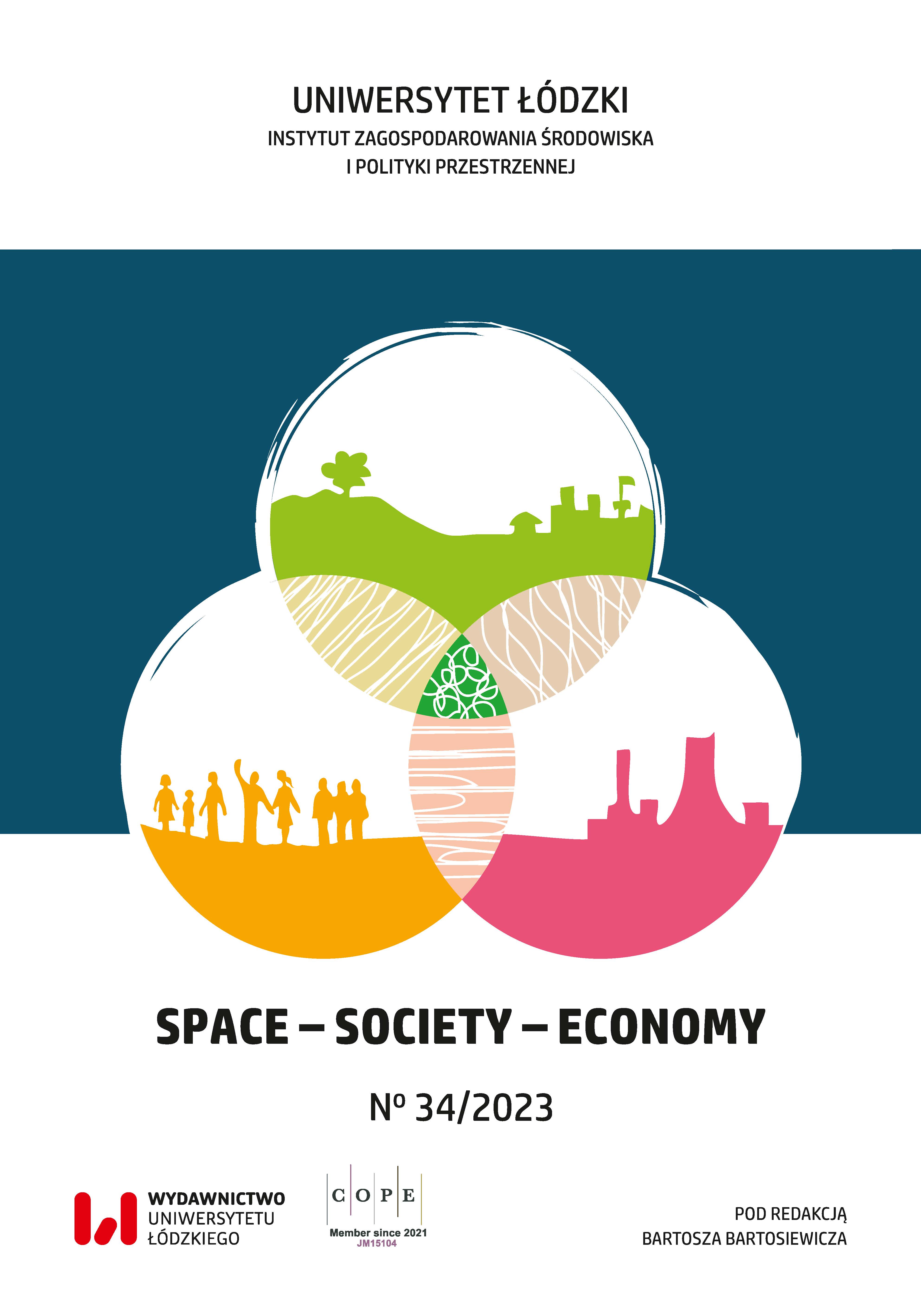The attractiveness of historic buildings in the Łowicz county according to their state of preservation
DOI:
https://doi.org/10.18778/1733-3180.34.07Keywords:
manor, wooden houses, monument, the state of preservation of objects, the attractiveness of objects, the Łowicz CountyAbstract
The aim of the article was to present the current state of preservation and attractiveness in terms of the condition of the historic manor houses and wooden houses in the Łowicz County. The author wanted to draw attention to a serious problem related to the preservation of cultural heritage. In this area, there are currently 146 cottages and 14 manor houses listed as historic monuments. Although these buildings are listed as monuments, there are situations where they are not properly preserved or have long ceased to exist. This development of the matter has been aided by human passivity (in the past, insufficient attention was paid to monuments) and the lack of funds for renovations. Therefore, it is now necessary to pay greater attention and be aware of the existence of not only well-known, renovated, and attractive monuments, but also those in need of rescue (their fate partly lies in our hands). It is worth mentioning that private owners find it more difficult to obtain grants and funds for renovations (which should not be the case, as this heritage has shaped the history of this area). Manor houses and cottages are significant elements that showcase the history of the Łowicz County, and so they should be nurtured to remain for future generations. Therefore, we make it a point in the article to present the number of objects that have a chance to remain in space/landscape for a long time (buildings in good and fair condition) and to approximate the part that will become ruins or collapse completely in the near future if no action is taken (buildings in poor condition and ruins). Attractiveness in terms of condition was examined using the direct comparison method, while the condition was analysed based on the author’s inventory cards made in the field and compared with those obtained from the Voivodeship Office for the Protection of Monuments. The obtained results allowed the determination of the actual condition of manor houses and wooden houses in the Łowicz County as well as updated information for this area in the registry of monuments. The highest number of manor houses, i.e. as many as seven, were assessed as being in poor condition, while only three objects were classified as being in good condition. By creating a matrix of direct comparisons for manor houses and parks, it was possible to create a ranking of the most attractive manor houses and green areas in terms of their condition in the Łowicz County. Objects in better condition were ranked higher. The most attractive buildings were the manor houses in Borów, Stanisławów, and Osiek, while the parks in Boczki, Chąśno, Borów, and Sobota were highly rated. It is worth noting that among the examined manor houses, buildings themselves were usually much more attractive than the surrounding parks (although this relationship was not noticeable in the case of the manor house located in Boczki). It is also worth mentioning that out of 76 plots, old wooden houses have already been demolished, but cottages can still be found on 70 plots. Additionally, among the wooden houses, those in poor condition predominated (32) and were not utilised by anyone anymore. Only a small minority, i.e. 13 buildings, were in good condition and, furthermore, some of them have already changed their original form, e.g. they have been plastered.
Downloads
References
Ciekliński Z., 1973, Zabytki województwa łódzkiego, budownictwo drewniane, Łódzkie Zakłady Graficzne, Łódź.
Google Scholar
Gotfryd M., 2007, Atrakcyjność turystyczna zamków w województwie małopolskim, „Prace Geograficzne”, 117: 43–52.
Google Scholar
Janiec E. i in. (red.), 2006, A-Zetka. Encyklopedia PWN, Wydawnictwo Naukowe PWN, wyd. 5, Warszawa.
Google Scholar
Jasion A., Latosińska J., 2020, Zamki, pałace i dwory w Polsce – rozmieszczenie i obecne wykorzystanie, „Studia z Geografii Politycznej i Historycznej”, 9–10: 205–229.
Google Scholar
DOI: https://doi.org/10.18778/8220-630-2.10
Kajzer L., 2010, Dwory w Polsce od średniowiecza do współczesności, Wydawnictwo DiG, Warszawa.
Google Scholar
Kendzierawska W., Trochonowicz M., 2022, Ocena stanu technicznego zabytkowych dworów – propozycja standaryzacji dokumentacji, „Teka Komisji Architektury, Urbanistyki i Studiów Krajobrazowych”, 4: 30–41.
Google Scholar
DOI: https://doi.org/10.35784/teka.3392
Kozak M., 2008, Dwory, pałace i zamki – kosztowne pamiątki czy zasób w rozwoju?, „Studia Regionalne i Lokalne”, 2(32): 92–111.
Google Scholar
Krakowiak B., Latosińska J., 2009, Muzea w dawnych rezydencjach – zamkach, pałacach i dworach, „Turyzm”, 1–2: 43–50.
Google Scholar
DOI: https://doi.org/10.2478/V10106-009-0005-x
Krassowski W., 2007, Problemy architektury polskiej. Schemat planów budynków mieszkalnych, Oficyna Wydawnicza Politechniki Warszawskiej, Warszawa.
Google Scholar
Krzesiwo K., Mika M., 2011, Ocena atrakcyjności turystycznej stacji narciarskich w świetle zagadnienia ich konkurencyjności – studium porównawcze Szczyrku i Białki Tatrzańskiej, „Prace Geograficzne”, 125: 95‒110.
Google Scholar
Kubiak A., 2015, Przekształcenia własnościowe i funkcjonalne nieruchomości dworskich i pałacowych w powiecie sieradzkim w latach 1945–2006, „Acta Universitatis Lodziensis. Folia Geographica Socio-Oeconomica”, 22: 43–64.
Google Scholar
DOI: https://doi.org/10.18778/1508-1117.22.03
Kucharska M., 2006, Nowa metoda oceny atrakcyjności turystycznej szlaków pieszych na przykładzie szlaków pieszych Oddziału Łódzkiego PTTK, „Turystyka i Hotelarstwo”, 10: 41–62.
Google Scholar
Miłobędzki A., 1957, Krótka nauka budownicza dworów, pałaców, zamków podług nieba i zwyczaju polskiego, Zakład Narodowy im. Ossolińskich, Wrocław.
Google Scholar
Pawlikowska-Piechotka A., 2003, Dwory o funkcjach turystycznych, „Ochrona Zabytków”, 1: 171–181.
Google Scholar
Pokropek M., 2019, Etnografia. Materialna kultura ludowa Polski na tle porównawczym, Wydawnictwo Naukowe PWN, Warszawa.
Google Scholar
Pukowiec K., Kurda W., 2015, Ocena wartości kulturowej i turystycznej w świetle sposobu zagospodarowania obiektów zabytkowych na przykładzie Zamków nad Piotrówką, „Studia Periegetica”, 2/14: 185–206.
Google Scholar
Rogowski M., 2012, Atrakcyjność turystyczna szlaków pieszych – metoda oceny, „Warsztaty z Geografii Turyzmu”, 2: 221–234.
Google Scholar
DOI: https://doi.org/10.18778/7525-713-7.13
Rogowski M., Kasianchuk A., 2016, Atrakcyjność turystyczna winnic Lubuskiego Szlaku Wina i Miodu, „Zeszyty Naukowe. Turystyka i Rekreacja”, 2(18): 101–118.
Google Scholar
DOI: https://doi.org/10.5604/01.3001.0010.6943
Rydel M., 2012, Dwór. Polska tożsamość, Wydawnictwo Zysk i S-ka, Poznań.
Google Scholar
Senetra A., 2010, Wpływ metodyki oceny walorów krajobrazowych na wyniki szacowania nieruchomości, „Acta Scientiarum Polonorum, Administratio Locorum”, 9/2: 113–127.
Google Scholar
Senetra A., 2017, Zmiany przestrzenno-czasowe wartości estetycznych krajobrazów obszarów pojeziernych na potrzeby ich audytu i ochrony na przykładzie gminy Pozezdrze, „Prace Komisji Krajobrazu Kulturowego”, 36: 63–77.
Google Scholar
Siejkowska A., 2008, Studia inwentaryzacji urbanistycznej, [w:] S. Liszewski (red.), Geografia urbanistyczna, Wydawnictwo Uniwersytetu Łódzkiego, Łódź: 373–391.
Google Scholar
Sikora D., 2016, Krajobraz rezydencjonalny – stan zachowania i zagrożenia, „Prace Komisji Krajobrazu Kulturowego”, 32: 83–92.
Google Scholar
Skowroński W. i in. (red.), 2008, Ilustrowany leksykon architektoniczno-budowlany, Wydawnictwo Arkady, Warszawa.
Google Scholar
Uchwała nr XVII/105/2016 Rady Powiatu Łowickiego z dnia 29 lutego 2016 r. w sprawie przyjęcia Strategii Rozwoju Powiatu Łowickiego 2020.
Google Scholar
Ustawa z dnia 23 lipca 2003 r. o ochronie zabytków i opiece nad zabytkami, Dz.U. z 2003 r., nr 162, poz. 1568, tekst jednolity.
Google Scholar
Wośko-Czeranowska A., 2011, Założenie dworsko-parkowe jako archetyp przestrzeni słabo zurbanizowanych, „Urbanistyka”, 16: 21–70.
Google Scholar
Wylegała A., 2022, Był dwór, nie ma dworu, Wydawnictwo Czarne, Wołowiec.
Google Scholar
Zachariasz A., 2013, Zespół dworski jako integralny element krajobrazu wsi. Problemy ochrony i współczesnego użytkowania (na wybranych przykładach z Polski południowej), „Architektura Krajobrazu”, 2/39: 4–29.
Google Scholar
Żółtowska J.E., 2012, Geneza i rozwój przestrzenny wsi Księstwa Łowickiego, Wydawnictwo Wyższej Szkoły Menadżerskiej, Warszawa.
Google Scholar
http://www.dialektologia.uw.edu.pl/ (dostęp: 25.04.2023).
Google Scholar
Downloads
Published
How to Cite
Issue
Section
License

This work is licensed under a Creative Commons Attribution-NonCommercial-NoDerivatives 4.0 International License.









